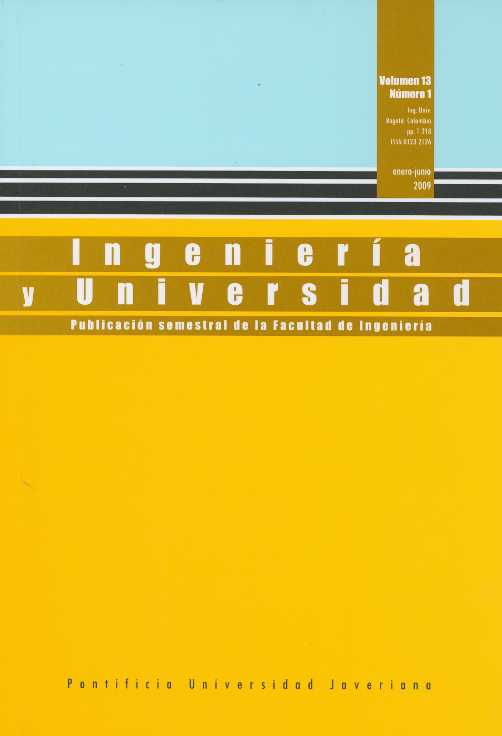Abstract
For more than 30 years, modified asphalt obtained by adding elastomer and plastomer type polymers has been used in flexible pavements. However, the high cost of modifiers has prevented their use from becoming popular; meanwhile no one has found a satisfactory method of final disposal for large volumes of waste polymer that has been generated by the indiscriminate use of disposable products. This work will study the possibility of obtaining an asphalt-polymer mix (using tire crumbs and icopor from disposable cups as modifiers), which would be stable, less expensive and have better physical and chemical properties than conventional CIB asphalt from the industrial complex in Barrancabermeja (Colombia). The modification of asphalt was conducted using the asphalt disperser of the pavements laboratory at the University of La Salle. Physicochemical analysis was conducted in accordance with regulations and included penetration, ductility, softening point, flash point, point of combustion, aging, reological curve, solubility and stability in storage. To establish the composition and compatibility of the polymerasphalt mixtures, the separation was performed in four fractions of asphalt according to the specifications of the SARA method, while the morphological and micromorphological analysis of asphalt and asphalt binders was performed using stereoscopic sweep electronic microscope. The results indicated that a stable and homogeneous asphalt – polymer mix was possible; one which preserved the original asphalt maltenes – asphaltenes relationship and the physicochemical characteristics which would predict an adequate performance when used in asphalt paving mixtures.
ARENAS, H. Tecnología del cemento asfáltico. 5a. ed. Cali: Fundación para Actividades de Investigación y Desarrollo, 2006.
COLLINS, J. et al. Improved performance of paving asphalts by polymer modification. Journal of the Association of Asphalt Paving Technologists (AAPT). 1991, vol. 60, pp. 43-79.
CORBETT, L. Relation between composition and physical properties of asphalt. Journal of the Association of Asphalt Paving Technologists (AAPT). 1970, núm. 39, pp. 481-491.
DAQUAN, S. et al. Storage stability of SBS-modified road asphalt: Preparation, morphology, and rheological properties. Petroleum Science and Technology. 2006, vol. 24, pp. 1067-1077.
FIGUEROA, A. et al. Análisis de un asfalto modificado con icopor y su incidencia en una mezcla asfáltica densa en caliente. Ingeniería e Investigación. 2007, vol. 3, pp. 5-15.
FIGUEROA, A. y REYES, F. Asfaltos modificados con poliestireno. Bogotá: Universidad de la Salle, 2005.
HESHMAT, A. Polymer modifiers for improved performance of asphalt mixture. Texas: Texas Transportation Institute, 1995.
HOIBERG, A. Bituminous materials, vol. 2. Asfaltos. New York: John Wiley & Sons, 1965.
INSTITUTO DE DESARROLLO URBANO (IDU) y UNIVERSIDAD DE LOS ANDES. Estudio de las mejoras mecánicas de mezclas asfálticas con desechos de llantas. Bogotá, 2002.
MONTEJO, A. Ingeniería de pavimentos, evaluación estructural, obras de mejoramiento y nuevas tecnologías. Vol. 2. 3a ed. Bogotá: Universidad Católica de Colombia, 2006.
OCAMPO, M.; CAICEDO, D., y GONZÁLEZ, D. Estudio de las mejoras mecánicas de mezclas asfálticas con desechos de llantas. Bogotá: Instituto de Desarrollo Urbano, 2007.
OCAMPO, M.; CAICEDO, B. y GONZÁLEZ, D. Mezclas asfálticas mejoradas con caucho molido proveniente de llantas. Revista de Ingeniería. 2002, núm. 16: 175-80.
PANAGIOTIS, F. Crumb rubber-bitumen interactions: Cold-stage optical microscopy. Journal of Materials in Civil Engineering. 2003, vol. 15, núm. 5, pp. 419-426.
REYES, F. Diseño racional de pavimentos. Bogotá: Editorial de la Escuela Colombiana de Ingeniería, 2003.
REYES, F.; MADRID, M. F. y SALAS, S. Mezclas asfálticas modificadas con un elastómero (caucho) y un elastómero (tiras de bolsa de leche) con asfalto 80-100. Infraestructura Vial. 2007, núm. 17, pp. 25-34.
RODRÍGUEZ, R. et al. Desarrollo de aditivos para asfaltos modificados con bajos contenidos de hule [documento en línea]. México: Instituto Mexicano del Transporte, 2001. < http://imt.mx/Espanol/Publicaciones/pubtec/pt160.pdf> [Consulta: 17-04-2009].
Shell Bitumen European Technical Team. Shell bitumen handbook. 15a ed. Virginia: American Society of Civil Engineering, 2004.
WILSON, A. et al. Localization of the polymer phase in bitumen/polymer blends by field emisión cryo-scanning electron microscopy. Energy & Fuels. 2000, vol. 14, pp. 575-584.
YIP, M. y DALTON, D. Organic chemistry in the laboratory. 2a ed. New York: Van Nostrand, 1979.

This work is licensed under a Creative Commons Attribution 4.0 International License.
Copyright (c) 2020 Ana Sofía Figueroa Infante, Elsa Beatriz Fonseca Santanilla, Fredy Alberto Reyes Lizcano


